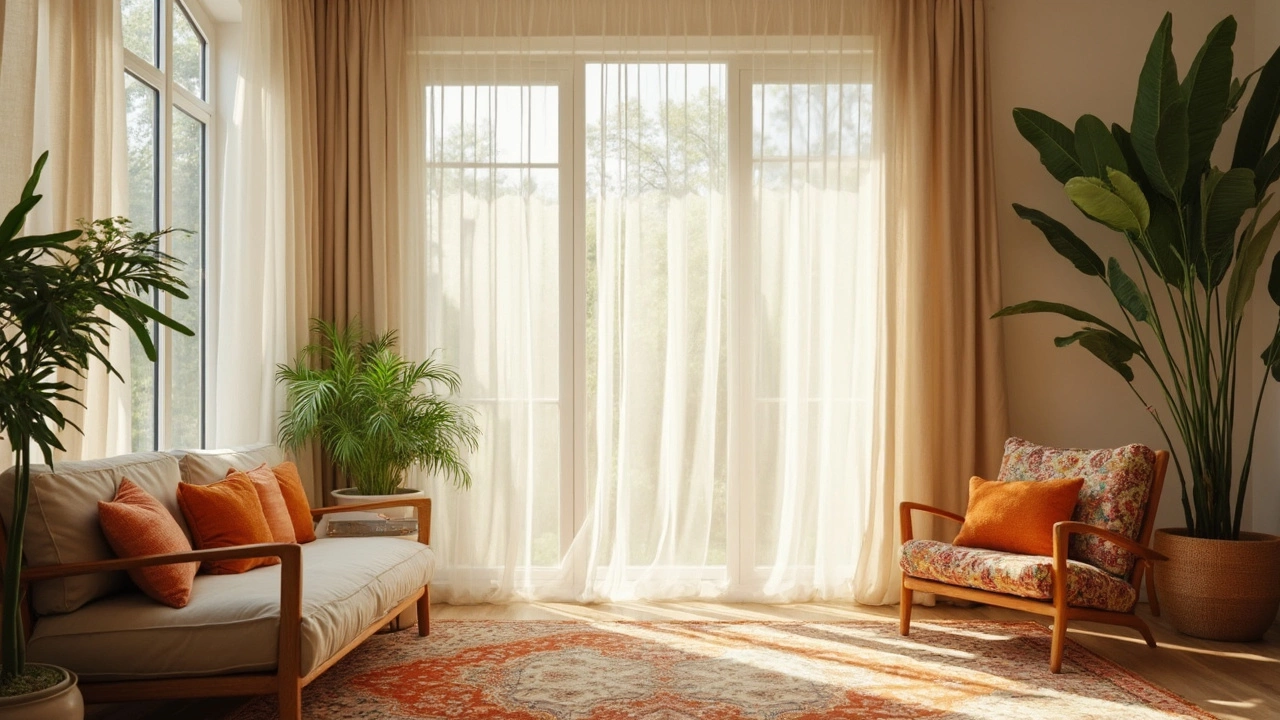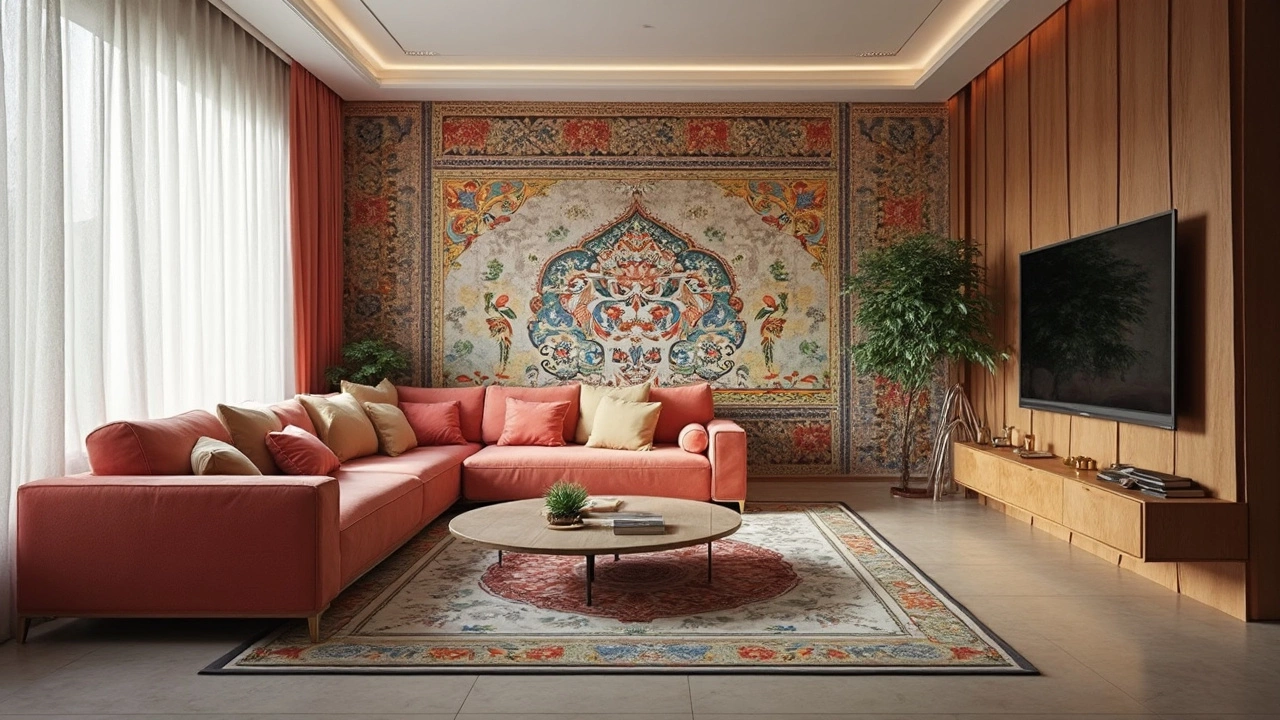Ever felt like your living room is closing in on you, even when you barely have stuff inside? The color of your curtains could be messing with your sense of space in a big way. This isn’t just about matching your couch—it’s about making your whole room breathe a little easier.
Light colors like white, soft beige, and pale gray work like magic when you need your room to feel open. They bounce natural light around, making walls seem further apart. On the flip side, dark or bold shades, though cozy, can box you in, especially if your space is already tight. But here's where most people get tripped up: it's not just about picking any light color. The shade, the texture, and how much sunlight you get matters more than you might think.
- Why Curtain Color Changes Perception
- Best Colors for Making a Room Feel Bigger
- Pairing Curtains With Walls and Windows
- Mistakes That Make Rooms Feel Smaller
- Smart Tricks for Stretching Visual Space
Why Curtain Color Changes Perception
Ever wondered why a room feels tiny or huge just by changing linens or curtains? It all boils down to how our eyes and brains react to color and light. Even professionals agree—color tricks your senses. In fact, a 2022 survey by the American Society of Interior Designers showed that 67% of designers pick curtain color first when aiming to change how big a room feels.
Lighter curtain colors reflect more daylight, spreading brightness throughout the space. When this happens, corners look less shadowy and cramped. Meanwhile, dark curtains suck up light, making the edges of the room fade into the curtains. Your eyes can't tell where the wall stops and the window starts. That shrinking feeling? Totally the wrong curtain color at work.
Here's a quick look at how popular curtain colors affect how big or small a room will feel:
| Curtain Color | Perceived Room Size Change | Light Reflection Level |
|---|---|---|
| White | Makes a room look much bigger | Very high |
| Soft Beige | Opens up space | High |
| Pale Gray | Feels spacious and airy | Moderate-High |
| Navy Blue | Can make room seem smaller | Low |
| Charcoal | Visually closes in space | Very low |
The bottom line? The brighter and lighter your curtain color, the more space you’ll fool your brain into seeing. If you want your curtain color to help a small room, always look at how much natural light you get and how close your furniture sits to the windows. These details make all the difference when picking what actually works, not just what looks nice in a catalog.
Best Colors for Making a Room Feel Bigger
The right curtain color can totally change how large your room feels. If you've ever stepped into a place that seemed airy even though it wasn't actually big, chances are somebody nailed the curtain color. It’s not a guessing game. There’s science behind why this works.
The golden rule: stick with light and neutral shades. Soft whites, off-whites, pale grays, and barely-there beiges top the list. These colors let natural light bounce off the fabric and all over your space, instantly stretching your walls further apart (visually, at least).
- Curtain color choice matters: White or light gray curtains almost always make a room feel larger and breezier because they reflect more light than they absorb.
- If you want a hint of color, pastel blues and greens are known for their calming vibe without making a room close in. These tones trick your eyes, so the corners of the room don’t look as sharp or defined.
- For rentals with bland paint you can't change, try curtains in soft taupe or ivory—these won’t clash with landlord-approved wall colors, but they’ll still help open things up.
Skip the shiny or highly textured fabrics for this purpose. Linen-style curtains, cotton, or lightweight sheers in these light shades work best because they aren’t heavy or overwhelming to the eye.
Check out this quick comparison of how different colors affect room size according to interior decorators’ polls from 2023:
| Color | Percent of decorators saying it makes rooms look bigger |
|---|---|
| White | 92% |
| Soft gray | 87% |
| Beige/Ivory | 85% |
| Pale blue/green | 68% |
| Bold/dark colors | 9% |
Want the easiest win? Match your curtains to your wall color, just one shade lighter or in the same color family. This creates a seamless look, so the curtains blend right in, making it nearly impossible for your eye to tell where the wall ends and the window begins. More light, fewer boundaries—simple as that.

Pairing Curtains With Walls and Windows
If you want your room to look bigger, you can’t just pick a curtain and hope for the best. You’ve got to line those curtains up with your wall color and window style. The golden rule: go as close as you can to the hue of your walls. When your curtains blend in, lines vanish, and—just like that—your space feels way more open.
It sounds basic, but here’s what decorators do:
- If your walls are off-white, pick curtains in a similar shade. No sharp contrasts. Even a difference of one shade lighter or darker is fine, but think harmony, not drama.
- Got pale gray walls? Gray curtains, maybe even a hint of silver or a soft sheer, make the whole setup seamless.
- If your trim or window frames are white, don’t clash with dark curtains. Stick with lighter options to keep those boundaries blurred.
If you’re dealing with a lot of sunlight, don’t sweat about curtains fading. Most modern fabrics are treated to resist sun damage. But if your room gets blasted with afternoon sun, lighter shades also hide fading better than bold colors.
Check this out for a cheatsheet:
| Wall Color | Recommended Curtain Color | Effect |
|---|---|---|
| White/Cream | White, Beige, Light Gray | Room looks brighter, bigger |
| Pale Gray | Light Gray, Soft Blue-Gray | Creates a seamless look |
| Pale Blue or Green | Very Light Blue, White, Pale Green | Stretches the visual space |
For curtain color that truly works with your windows, hang curtains higher and wider than the window frame. Curtain rods 4–6 inches above the window and extending past each side create the illusion of taller, wider windows and trick the eye into thinking your walls keep going. Go for sheer or lightweight fabrics if you want max sunlight and an airy feel—no one ever said, “Wow, this breeze makes the room look tiny.”
Mistakes That Make Rooms Feel Smaller
Plenty of folks get tripped up choosing curtains, especially if they’re hoping to make their room feel more spacious. It’s easy to slip into habits that shrink a space without realizing it. Let’s cut through the confusion and call out what really works against you.
- Dark Colors Are a Common Trap: Deep shades like navy, black, forest green, or burgundy soak up light. In small rooms, these will pull the walls in visually, which is the opposite of what you want with curtain color.
- Heavy, Thick Fabrics Cancel Out Sunlight: Thick velvets, dark linens, and blackout curtains stop natural light from spreading. Less light = less space, at least in how your eyes see it.
- Short Curtains Break Up Wall Height: Hanging curtains just above the window or opting for ones that don’t hit the floor chops up the wall, making ceilings feel lower and the room boxed in.
- Busy Prints and Bold Patterns Overwhelm: Large floral prints, harsh stripes, or busy graphics create visual clutter which can make a already-cramped room look even smaller.
- Matching Curtains Exactly to Dark Walls: This mistake turns walls and windows into one dark block, rather than breaking up the space, so you lose all depth and dimension.
Here's an easy chart you can use when deciding what not to do:
| Mistake | How It Shrinks the Room |
|---|---|
| Dark curtain colors | Absorb light, close in the space |
| Heavy, opaque fabrics | Block daylight, limit brightness |
| Short curtain length | Makes windows and ceilings seem shorter |
| Busy or bold patterns | Adds visual clutter, breaks up space |
| Matching dark curtains to dark walls | Eliminates contrast, flattens the room |
If you spot these mistakes in your room, swapping them out can make a difference fast. Focusing on lighter, simpler curtain color will help your space feel wider, taller, and a lot more comfortable to hang out in.

Smart Tricks for Stretching Visual Space
You don’t need magic—just some clever hacks to make your room look way bigger without busting out the sledgehammer. The right curtain moves can instantly make your space feel taller, wider, and way less cramped.
- Hang curtains high and wide: Don’t stop right at the top edge of your window. Go several inches above (even right up to the ceiling if you can) and extend the curtain rod past the sides of the window. This gives the illusion that your windows—and room—are much larger.
- Match curtain color to your walls: When your curtains blend in with your wall color, there are no harsh breaks. It’s kind of like a cheat code for making walls look continuous and rooms flow better.
- Go sheer when in doubt: Sheer curtains let loads of natural light pour in while still offering privacy. More light means a bigger feel, especially in small spaces where heavy drapes can eat up visual space.
- Pick lightweight fabrics: Thick, heavy materials can feel bulky and overwhelming, while lighter fabrics keep things feeling open and breezy.
- Try vertical patterns: Subtle stripes going up and down will trick the eye into seeing more height. Just avoid bold prints if your room is tiny—they can create clutter visually.
If you like hard numbers, consider this: real estate experts say rooms with high-mounted curtains can look up to 25% taller. That’s a lot without knocking down a single wall.
| Trick | Visual Effect |
|---|---|
| Hang curtains high & wide | Windows appear broader, ceilings seem higher |
| Color-match to walls | No strong lines, room feels continuous |
| Sheers & light fabrics | Max natural light, no visual heaviness |
| Vertical patterns | Makes walls seem taller |
One last thing—clean lines do wonders. Skip fussy tassels or super busy tiebacks. The less stuff hanging around the window, the cleaner and more open the whole room feels. Master these tricks and you’ll be shocked at how much bigger your spot can look, even if you’re starting with a shoebox.



